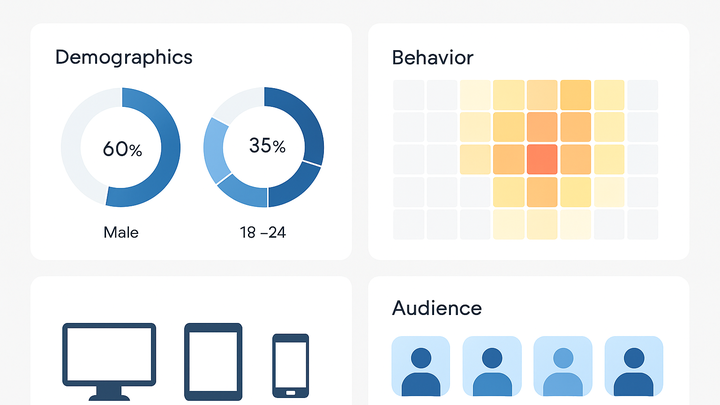Published on 2025-06-28T07:43:34Z
What are Audience Insights? Examples for Audience Insights.
Audience Insights refers to the deep understanding of website or app users by analyzing their behaviors, demographics, interests, and engagement patterns. In the analytics industry, Audience Insights help marketers and product teams identify key user segments and tailor experiences accordingly. Tools like Google Analytics 4 (GA4) and PlainSignal (a privacy-first, cookie-free analytics platform) provide dashboards that visualize these user attributes in real time. By examining metrics such as age, gender, location, device usage, and user journeys, teams can optimize campaigns, improve retention, and drive growth. Audience Insights underpin data-driven marketing strategies, enabling personalized messaging and efficient resource allocation. With customizable segments and predictive features, organizations can anticipate user needs and adapt quickly to evolving trends.
Audience insights
Analysis of user demographics and behaviors to inform targeted marketing, product decisions, and personalization.
Key Components of Audience Insights
Audience Insights typically encompass several core dimensions that collectively paint a comprehensive picture of your users. Understanding each component helps teams develop targeted strategies and measure success effectively.
-
Demographics
Data on user attributes such as age, gender, location, and language, which helps in identifying who your users are.
-
Behavioral patterns
Information on how users interact with your site or app—pageviews, session duration, click paths, and more—to reveal usage trends.
-
Interests & affinities
Insights into user preferences and interests based on browsing habits and content consumption, useful for content personalization.
-
Engagement metrics
Measures like bounce rate, conversion rate, and event interactions that indicate how effectively users engage with your product.
Why Audience Insights Matter
Leveraging Audience Insights enables organizations to align their marketing, product, and content strategies with actual user needs and behaviors.
-
Improved targeting
Segment your audience to deliver tailored messages, ads, or features, reducing wasted spend and increasing ROI.
-
Personalized experiences
Use insights to customize content, recommendations, and user flows, fostering engagement and loyalty.
-
Data-driven decision making
Inform product roadmaps, campaign optimizations, and resource allocation with empirical evidence rather than assumptions.
Gathering Audience Insights
Analytics platforms aggregate data to produce actionable Audience Insights. Here’s how GA4 and PlainSignal approach data collection and reporting.
-
Google analytics 4 (GA4)
Google’s next-generation analytics offering, focused on event-based tracking and machine-learning capabilities.
-
Event-based model
Captures every user interaction as an event for granular analysis.
-
Predictive audiences
Uses machine learning to forecast user behavior and segment high-value audiences.
-
-
PlainSignal
A privacy-first, cookie-free simple analytics solution designed for ease of use and compliance.
-
Cookie-free tracking
Respects user privacy while collecting essential metrics without relying on cookies.
-
Easy setup
Integrate with a single script to start capturing insights immediately.
-
Example Implementation with PlainSignal
To start collecting Audience Insights with PlainSignal, add the following snippet to your website’s
<head> section:
-
Tracking code snippet
<link rel="preconnect" href="//eu.plainsignal.com/" crossorigin /> <script defer data-do="yourwebsitedomain.com" data-id="0GQV1xmtzQQ" data-api="//eu.plainsignal.com" src="//cdn.plainsignal.com/plainsignal-min.js"></script>
Leveraging Insights for Strategy
Once data is collected, apply Audience Insights to refine marketing and product initiatives for measurable impact.
-
Custom audience segmentation
Create segments based on behavior or demographics to target campaigns more effectively.
-
Content & campaign optimization
Use performance data to tweak messaging, channels, and creative for higher engagement.
